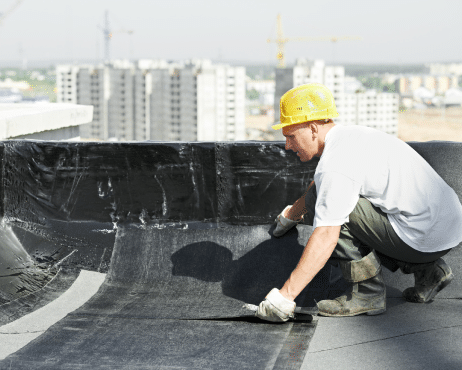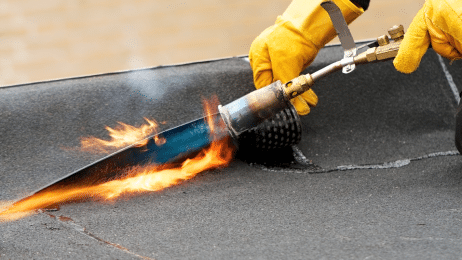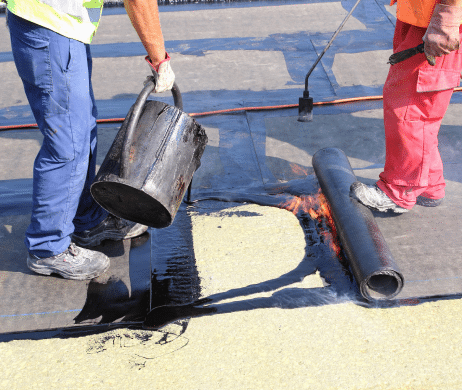Asbestos Roof Felt
Asbestos roofing felt provided a fire-resistant underlayment for roofs from the 1940s until well into the 1980s. Uncoated roofing felt was comprised of up to 87 percent asbestos. Roofers may have consequently been exposed to significant levels of asbestos almost daily when it was in popular use. They may still encounter asbestos felt today when working on older buildings.
Home » National Mesothelioma Law Firm » Asbestos Exposure » Asbestos in Consumer Products and Materials » Asbestos in Roofing Felt
What Is Asbestos Roofing Felt?
Why Was Asbestos Used in Roofing Felt?
How Are People Exposed to Asbestos Through Roofing Felt?
When Did Roofing Felt Contain Asbestos?
What Companies Manufactured Asbestos Roofing Felt?
How Can I Determine Whether Roofing Felt Contains Asbestos?
What Should I Do if I Suspect Asbestos in Roofing Felt?
What Are the Health Effects of Asbestos in Roofing Felt?
Who Can I Sue if I Was Exposed to Asbestos in Roofing Felt?
Contact The Lanier Law Firm to Start Your Mesothelioma Claim
Asbestos was a prized product in building construction from the early 1900s until the late 1970s because it was resistant to fire, extreme temperatures, decay, and moisture. It was strong, flexible, and readily available. These features made it useful for roofing felt in the extreme conditions on rooftops in most climates.
What Is Asbestos Roofing Felt?
Roofing felt is a paper-like underlayment placed beneath roofing shingles to serve as a moisture barrier. It is also used to seal flashing and repair punctures or other damage. It is a common component in built-up roofing systems.
Asbestos roofing felt was made by combining cellulose fibers and other fillers with asbestos, resulting in an asbestos content of 85 to 87 percent, according to the Rotterdam Convention. The material was then sent to a series of machines for heating and rolling to create sheets of uniform thickness.
The dried felt was cut to the appropriate width and saturated with asphalt or tar. Asbestos was also commonly used in tar and asphalt, adding to the high asbestos content already in roofing felt.
Why Was Asbestos Used in Roofing Felt?
The addition of asbestos to roofing felt increased its rot resistance and added an insulation feature along with fire resistance. The flexibility of asbestos fibers provided dimensional stability, which allowed the roof to expand and contract with fluctuating temperatures. This was especially important in flat roofs that tended to have poor drainage.
How Are People Exposed to Asbestos Through Roofing Felt?
Asbestos exposure through roofing felt may have occurred at any stage during the manufacturing process, especially as the asbestos was fed into the machine and after the uncoated felt was dried and cut to width. Exposure also would have occurred during the roof installation when the felt was cut to size.
After installation, asbestos could be released if the material became damaged or if it was cut for the purpose of performing repairs, demolition, or removal.

Occupations at Risk of Roofing Felt Asbestos Exposure
Anyone involved in the manufacture, installation, or removal of roofing material may have experienced occupational asbestos exposure, including roofers, handymen, or workers in factories where roofing felt was produced.
Any worker who installs products that impact a roof with asbestos felt could be exposed, even to this day. This may include the following:
- Chimney installation and repair professionals
- Skylight installers
- Cable and electronic product installers
Workers that provide renovations, restoration services, demolitions, or other services on buildings with damaged roofs may also be exposed to asbestos in roofing felt, including the following:
- Construction workers
- Water damage restoration workers
- Historical property preservation workers
- Firefighters
When Did Roofing Felt Contain Asbestos?
Asbestos roofing felt was manufactured from the 1940s until well into the 1980s after the general public became aware of the health hazards associated with asbestos. Any house built before 1990 may have asbestos roof felt if it still has the original roofing materials.
What Companies Manufactured Asbestos Roofing Felt?
The following asbestos companies manufactured asbestos roofing felt or supplied it:
- B.F. Goodrich Corporation
- Bird & Son Corporation
- Cascades, Inc.
- Celotex Corporation
- Johns Manville
- Koppers Corporation
- Nicolet, Inc.
- Owens Corning Fiberglass
- Plant Rubber & Asbestos Corporation
- Power Marketing Group (distributor only)
- Reynolds Metals Corporation
- Southern Roofing & Metal Company

How Can I Determine Whether Roofing Felt Contains Asbestos?
There is no way to tell by visual inspection alone, but if the roof has been there since before 1990, you should suspect it has asbestos. However, you should not climb to the roof and attempt to determine this yourself. A professional testing company is well-equipped to safely perform such a test.
What Should I Do if I Suspect Asbestos in Roofing Felt?
You should have it tested before performing any work that would involve cutting into materials on the roof or otherwise disturbing them. If you have asbestos in your roofing felt, you likely have asbestos in your shingles as well. Even walking on the roof could disturb asbestos.
If the material being removed is 160 square feet or larger, the method of removal falls under the supervision of the Environmental Protection Agency (EPA) under the asbestos National Emissions Standards for Hazardous Air Pollutants (NESHAP).
Projects larger than 160 square feet but smaller than 5,580 square feet are only subject to the asbestos NESHAP if the asbestos is not wetted during removal. Projects larger than 5,580 square feet are subject to asbestos NESHAP.
Asbestos NESHAP was imposed under the Clean Air Act. Building owners of affected structures must follow specified work practices for performing demolitions and renovations of structures, installations, and buildings that are not residential buildings with four or fewer dwelling units. Among the work requirements is a thorough inspection before work is initiated.
What Are the Health Effects of Asbestos in Roofing Felt?
People exposed to asbestos in roofing felt may experience significant asbestos exposure due to the high asbestos content in the felt and asbestos that may be released from other roofing materials while accessing the felt, including tar, asphalt, shingles, adhesives, and sealants.
People who work on roofs daily over an extended period have the highest risk of developing mesothelioma, asbestos-related lung cancer, and asbestosis. These are devastating illnesses that often result in a significantly shortened lifespan. These conditions most often develop 20 to 40 years after the first exposure.
Who Can I Sue if I Was Exposed to Asbestos in Roofing Felt?
Asbestos exposure lawsuits are often filed against manufacturers and suppliers of asbestos products. To prevail, you must prove that you have developed an asbestos-related illness and that you worked with asbestos provided by the defendant.
Some asbestos companies have filed for bankruptcy and reorganized under Chapter 11 of the U.S. Bankruptcy Code. These companies have established asbestos trust funds. If you can connect your illness to one of these companies, you may be able to file an asbestos trust fund claim without the need to involve the court.

If you were exposed to asbestos while working as a roofer or in another occupation, you may also qualify for workers’ compensation, depending on the jurisdiction where your case is located. If your employer was the U.S. military and you were on active duty, you may qualify for VA benefits for asbestos exposure.
Our mesothelioma law firm can help you identify the companies responsible for your asbestos exposure and determine the type of claim for which you qualify. You may qualify for multiple claims.
Contact The Lanier Law Firm to Start Your Mesothelioma Claim
You deserve financial compensation if you contracted mesothelioma or another asbestos-related illness. Our compassionate and dedicated attorneys have seen first-hand the devastation caused by a mesothelioma diagnosis.
We will take the stress out of the legal process to the fullest extent possible and provide skillful, aggressive representation while you focus on your medical treatment.
We have recovered nearly $20 billion from verdicts and settlements on behalf of our deserving clients. When you hire a mesothelioma lawyer from The Lanier Law Firm, you can rest assured that you are in the hands of an experienced, reputable attorney who will fight for you. Contact us today for a free consultation.
By submitting this form, you agree to our terms & conditions. Please read the full disclaimer



